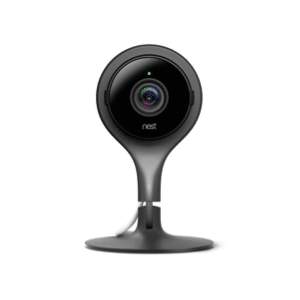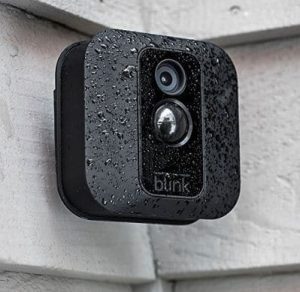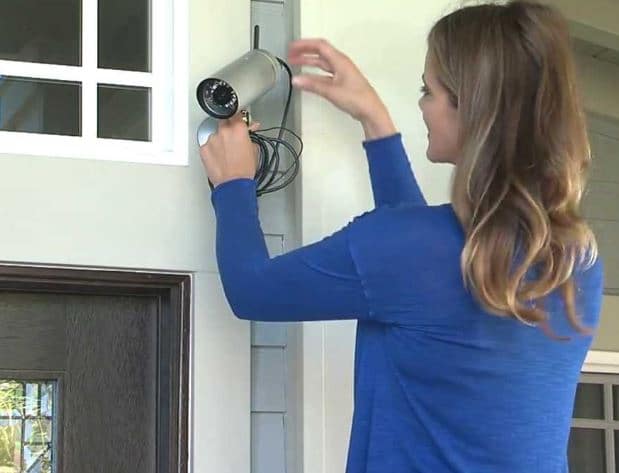Tips for Placing Security Cameras Around Your Home
Once you’ve decided to add security cameras to your home, choosing where you will place them is critical to getting the most benefit. Obviously, a camera can only record what happens in its field of view. If your cameras are installed without much thought, they may miss the most important events that they are meant to record such as prowlers in the yard or burglars breaking into the house.
Camera Considerations
Things to think about when deciding on the best placements for indoor and outdoor security cameras include:
- Areas most likely to be attractive to intruders
- Whether you need a wide-angle or narrow field of view
- How the cameras store the video that they record
- If the cameras will need extra light for best picture quality
- How to avoid having your cameras stolen or destroyed by miscreants
- To self-install or to call a professional
User shown viewing their Blink security cam on mobile app
Home Security Apps are available to help you answer many of these questions and decide on the most effective camera placements for your home, or you can use some good thinking to figure it out on your own. Start with a revie ofw your house and yard layout.
Think of what you most need to protect and what parts of your property are most vulnerable to thieves. Statistics show that almost a third of criminals enter homes through the front door, so that is an area to cover with surveillance cameras for sure. Nearly another quarter of break-ins come through back or side doors, with a similar percentage of burglars using a ground floor window for access.
Windows or doors that are out of public view, on the side or back of the house, for instance, or shielded from view by foliage, deserve special attention. Criminals appreciate areas that are out of public sight to access your home. Think of camera placement that is designed to cover areas that are shielded from street view especially.
Indoor Cameras
Cameras inside your house can be aimed at vulnerable spots for entry, including all ground level windows and doors. The contrast between low lighting levels inside and bright sunshine around doors and windows can be tricky for surveillance cameras, though. Look for security cameras with WDR (Wide Dynamic Range) that lets them capture details clearly in these hard-to-film areas of sharp contrast between light levels.
Nest indoor cam with WDR but not quite a fish eye
Consider setting up cameras to record areas of special concern in your house, including kids’ rooms and places where you keep valuables, like a safe or bedroom closet or dresser drawers, for instance. Experts recommend using hidden cameras to avoid having the camera destroyed or stolen by the thieves. For similar reasons, the video recordings that the camera make should be stored elsewhere, either remotely on your computer or in the cloud, so that the record of the robbery is accessible even if the camera is removed or damaged.
- Live Steam from Anywhere with Pan/Tilt: Sharp and clear 1080p Full HD provides high quality video right in the palm of...
- Real-Time Motion/Sound Detection: Get alerts on your smart phone whenever motion or sound is detected even at night...
- Secure Your Videos Locally or with AWS Cloud: EC70 mini camera continuously records and stores footage or video clips on...
Outdoor Cameras
In the yard, the most effective security cameras record activity near garages or sheds, which criminals may be tempted to investigate for expensive lawn and garden equipment, bikes, or other items of value. If you have aimed indoor cameras at home doorways and windows that may be vulnerable to break in, you may not need outdoor cameras covering the same area, or you may want a view of the area outside as well as inside the doors and windows.
- 24/7 live video: 130 Degree view shows your home in 1080P HD day and night.
- Weatherproof: Camera cable and adapter are all weatherproof.
- Clear as day even at night: Night vision evenly illuminates the whole scene. See who's at the door and talk back to get...
Field of Vision
Security cameras come in a variety of angles of vision. Those with a range of 45 to 75-degree field of vision are best for getting details, such as a good view of the faces of strangers around your property.
Wide-angle cameras from 75 to 180-degree vision cover a wider area of the space in front of them but provide a lower level of detail. Be sure to consider the camera’s field of vision when you decide where it will be placed and what you hope to record with it.
Lighting or Night Vision
Many good surveillance cameras include IR (Infrared) lighting to improve the clarity of the video when filming at night. It may be even more effective to combine your camera placement with motion sensor lights, so that any movement in the area of the cameras at night will be well lit when the camera records.
Out of Reach/Out of Sight
Criminals have a habit of looking for security cameras, whether placed indoors or out, and doing their best to remove or disable them. Mount the camera in a place where it is difficult to reach, usually at least 9 or 10 feet off the ground to decrease the risk of thieves accessing it. It may be worth adding wire mesh protective covering over outdoor cameras as well, to avoid damage by rocks or sticks used as weapons against the camera.
One trick to outsmart thieves is to use decoy fake cameras that look real in plain view, with the real camera hidden out of sight. Criminals may waste time and effort destroying the inexpensive fake camera, leaving the real camera recording, unseen by them.
Self-Install or Call a Pro?
Not too difficult of a task; does require drilling. Image credit: Link Interactive
There are a few factors to consider when deciding whether to install your own cameras or call a professional.
- Wiring — does the camera require wiring into your home’s power source, can it be plugged into an outlet, or is it battery powered?
- Mounting — does the camera come with simple mounting brackets or does it require drilling into walls for secure mounting?
- System complexity — is the camera a stand-alone unit, or part of a larger security system or multi-channel system?
- Set up — How difficult is it to get your camera up and running and recording good quality video? Some cameras are easier than others to set up and operate.
For a free professional quote check out ADT or Vivint who will send a tech out and install for you. Both have their own mobile apps for user viewing free of charge.
Keep an Eye on Things for Security and Peace of Mind
Security cameras on your property can be one of the most effective ways to deter crime, as well as improving your chances of identifying and catching the criminal in the event a crime does occur. To get the most out of your camera though, it is crucial to spend some time before installation to think of the best locations for your security cameras. If you work with a professional for installation, you are likely to get good advice from the pro, but if it is a DIY project, you need to do the thinking about how to find the best placement for indoor or outdoor security cameras to get the most out of your investment.
Latest Posts
- 3 Ways to know your Alarm System is Outdated
- Vivint vs ADT
- 7 Best Outdoor Motion Sensor Lights for Homes
- Top Home Security Systems in Atlanta, GA
- How to Cancel Your Alarm Contract

Growing up with Law and Order and CSI shows taught Isabelle Landau one thing: if people back then had high-quality home security systems, those series would have been way shorter. In our modern world, technology helps us keep burglars away easily, and this is what Izzy studies and writes about: alarm systems, home security, protection systems, and more.
Last update on 2023-05-14 at 03:33 / Affiliate links / Images from Amazon Product Advertising API








Rey says
Hidden cameras are the way to go, this would give intruders a more difficult time in disabling it or simply not mind that there is a camera actually recording his/her every move! Placement is tricky though, you would want a place something that as much as possible would cover all important bases.
Betty U says
I wonder if there will be a time when one camera would just have everything! I understand currently the available choices would depend on your specific need. Unless I am mistaken and there really is an ultimate camera available that would fit everything! No shock however if the price tag would be hefty haha